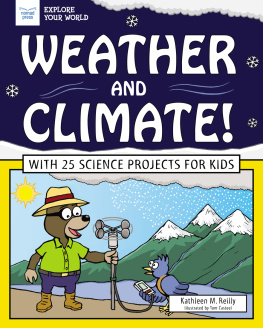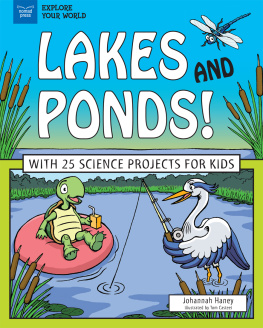The authors would like to thank Thomas van Kalken, Anna Zagorski, Rebecca Caban, Jessica Boddy, Anthony Knight, Jack Teagle, Meredith Halpern-Ranzer, Mary Claire Cruz, Marissa Asuncion, Amy Cloud, and Steven Malk.
Copyright 2020 by Tinkercast LLC
Illustrations copyright 2020 by Tinkercast LLC
All rights reserved. For information about permission to reproduce selections from this book, write to or to Permissions, Houghton Mifflin Harcourt Publishing Company, 3 Park Avenue, 19th Floor, New York, New York 10016.
hmhbooks.com
Cover illustration by Jack Teagle
Cover design by Mary Claire Cruz
Library of Congress Cataloging in Publication Data is available.
ISBN: 978-0-358-47015-1
eISBN 978-0-358-51320-9
v1.0620
Welcome to Two Whats and a Wow, a game show you can play IN A BOOK!
Thats rightA PLAYBOOK!
In this playbook, youll find 37 rounds of Two Whats?! And a Wow! In each round, we list three odd, interesting, and unusual statements on a scientific theme. Only one of these statements is a true WOW. The other two? Just a couple of made up WHAAAAATS?! Its up to YOU to flex your mind muscles to identify the one true WOW. Once youve made your guess, just flip the page, and the correct answer will be revealed! (Dont forget to give yourself a drumroll before the big reveal!)
But thats not all...
After each round, we leave you with a little scientific challenge to keep the Wow rolling. Most of these challenges require odds and ends you already have at home, and all of these challenges are best shared with a friend or family member. Its important to have someone there to catch your eyeballs when they pop out of your head from all that Wowing!
We hope you have as much fun playing with this book as we had making it. Now go forth and find those Wows!
Mindy & Guy

1

Inventoritos

Which of the following statements about INVENTIONS is the one true WOW?
A) Scientists have invented a clock that is powered entirely by grasshoppers.
B) Cotton candy was invented by a dentist.
C) The invention of the inside-out sandwich went down in history as the biggest food flop of the 1950s.
If you guessed B) Cotton candy was invented by a dentist, then CONGRATURITOS! You found the WOW!
Cotton candy was invented in 1897, when a dentist named William Morrison teamed up with a candy maker named John C. Wharton. Together, they created an electric machine that spun heated sugar through a screen, whipping it up into piles of thin, floss-like strands of sugar. At the time, they called their sweet invention Fairy Floss, and in 1904, they introduced it at the St. Louis Worlds Fair for 25 cents a box ($7.00 in todays money). People went BONKERBALLS for it! In 1921, another dentist, Dr. Josef Lascaux from New Orleans, improved the design of the original machine and presented the sweet treat as Cotton Candy. The rest is dental history.
Cotton Candy Around the World
Imagine if you were the one to invent cotton candy for the very first time. What would YOU call it?
Operation: Candy Creation
Calling all inventoritos! We challenge you to invent an entirely new, one-of-a kind candy! To do this, you may want to experiment with melting, freezing, smashing, or mixing two or more existing candies. Does your candy have a savory side? Is it gummy, crumbly, or not-so-yummy? Whats the size? Whats the shape? What would it look like on a cake? Once youve completed your candy, give it a name! Give it a wrapper! And treat yourself to this sweet lil snacker!
2

Giraffe Gaffes and Facts

Which of the following statements about GIRAFFES is the one true WOW?
A) Average giraffe tongues can grow to the length of an adult hand.
B) Humans have the same number of neck bones as giraffes.
C) A baby giraffe is called a girbull.
If you guessed B) Humans have the same number of neck bones as giraffes, then CONGRATURITOS! You found the WOW!
With their strong long necks stretching 15 feet (4.6 m) into the tree canopies of Africa, you wouldnt think that a giraffe neck had anything in common with a human neck, but guess again! It turns out that giraffes have the same number of bones in their necks as humans. Both human and giraffe necks are made up of seven vertebrae. Vertebrae are bones that run from your head to your hips, and they make up whats known as the vertebral column. But while a human neck bone measures around half an inch in length, a single giraffes vertebrae can grow to be over 10 inches (25 cm) long!
How to Sleep Like a Giraffe in Three Easy Steps
Step 1: Assume a standing position.
Step 2: Snooze with one eye open and both ears alert.
Step 3: Wake up 5 minutes later.
Giraffes are considered to be some of the strangest sleepers in the animal kingdom, sleeping in spurts for a total of anywhere between 30 minutes and 4 hours a night! Do you or someone know have any interesting sleeping habits?
Operation: Leaning Tower of Neck!
Measuring in at six feet long, adult giraffe necks are about the same length as some adult humans entire bodies! Try building your own six foot (1.8 m) giraffe neck using stackable things from around your home. A column of canned foods? A tower of blocks? Test which materials work best to help you reach new heights. Once you finish, be sure to give your giraffe neck a head and a name, and introduce your family to your new, long-necked pet.
3

Freezing Factoids and Fallacies

Which of the following frozen statements about ANTARCTICA is the one true WOW?
A) The first ice cubes were accidentally invented by scientists on an Antarctic expedition.
B) Ice skating Olympic hopefuls from around the world travel to Antarctica for training every year.
C) Antarctica is actually a desert.
If you guessed C) Antarctica is actually a desert, then CONGRATURITOS! You found the WOW!
When you think of a desert, you probably imagine a blistering sun hanging in the sky, boundless sand dunes stretching toward the horizon, and maybe a palm tree. But not all deserts are hot. In fact, the largest desert in the world is found in Antarctica! This is because deserts arent measured by heat or grains of sand. What makes a desert a desert is how much rain the region receives per year. And in Antarctica, it rains less than 2 inches (51 mm) each year on average. By comparison, New York City receives an average of 51 inches (1,295 mm) of rain a year!








 Inventoritos
Inventoritos 